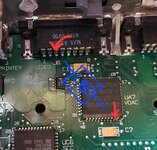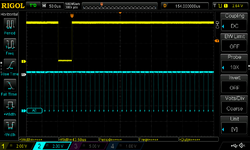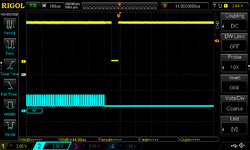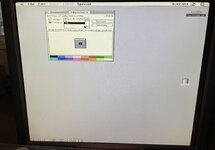This is what these adapters are for. It's why we tell all the new starters to get ten switch adapters. It feels like CSync is broken on his IIci, or toasted in the adapter.
I'm pretty confident at this point that the 10 switch adapters don't have any special sync splitting capability. My tracing with the multimeter just shows that the relevant switches (5-7) dumbly forward the signals from one pin to another. It's also consistent with how the modes are described in the user manual.
You got that right!
Okay, so here I am with my first set of oscilloscope traces from the IIci. Note that I don't have a PRAM battery installed, so it booted up outputting a black and white signal. That's probably good for simplicity anyway.
I tied pins 4 and 14 of the DB-15 connector together, to ground ID.0 and request 640x480 mode. I set up my trigger on CSYNC with a long enough pulse detection width to catch the longer vertical sync portion of it.
Here is what pin 3 (CSYNC) looks like. Seems pretty reasonable. You can see the shorter HSYNC pulses and the longer VSYNC pulse combined with the HSYNC pulses during it. Pretty nicely matches the CSYNC diagram in Figure 5-2 in the IIci dev note.
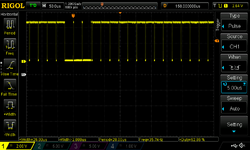
Now let's add pin 2 (red video) into it as channel 2:
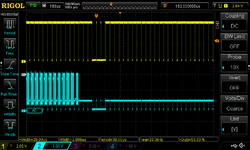
This confirms my suspicions. You can see some red video data on the left side, but the sync info is clearly also present in the lower voltage range. Now let's look at pin 5 (green) on channel 2 instead:

It's the same thing. Sync info is clearly available in the lower voltage range.
Spoiler alert: blue (pin 9) looks the same too. Won't even bother posting a picture. So the IIci not only outputs sync on green...it also outputs sync on red and sync on blue! Just like the 478 datasheet says it will do.
Now, what about the separate sync signals? The dev note already told us that the IIci doesn't output the separate sync signals in 640x480 mode. I'll check them anyway.
Now vsync (pin 12) is channel 2 below:

Nothing. Apple didn't lie! I even zoomed way out. The signal just isn't there at all.
Same with hsync (pin 15). It just stays high. No need to even share that picture.
So yeah. Unless you have an adapter that can split the combined sync signal out into separate H and V syncs on the VGA side, the IIci in 640x480 mode is only going to be compatible with monitors that support sync on green or can detect the composite sync if you forward that through.
The manual for the 10 pin adapter that BMOW shared even
makes it clear that none of the combinations split DB-15 pin 3 into separate VGA pins. "Mode 1" only forwards DB-15 CSYNC to the VGA HSYNC. "Mode 2" shorts CSYNC and HSYNC together on the DB-15 side, and only outputs it to HSYNC on the VGA side. That's all consistent with the
list I made in this post.
Whew, now I'm tired! I do still kind of want to run the same tests in portrait mode to confirm that the syncs are no longer present in the red/green/blue signals at that point.

